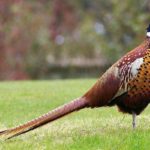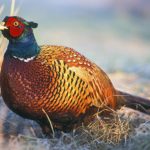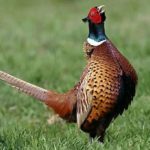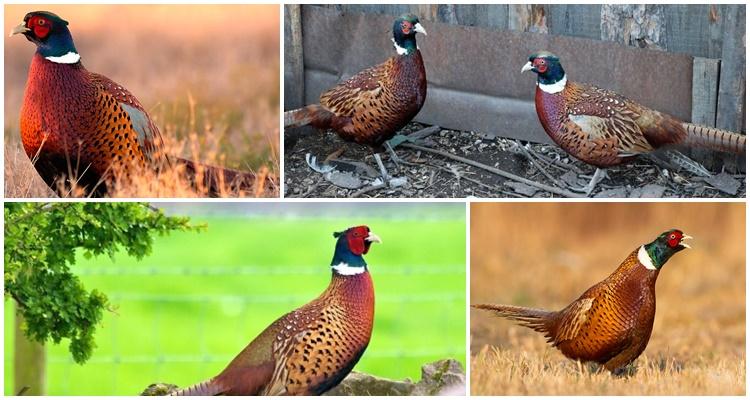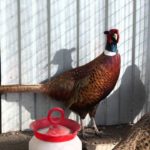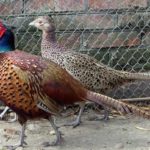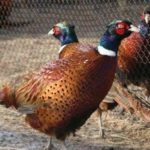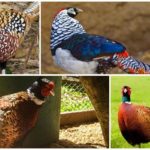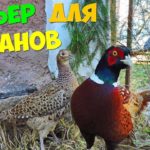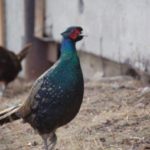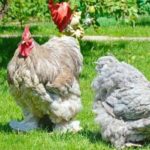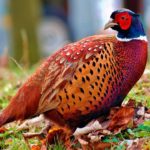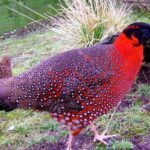Hunting pheasants are bred in small quantities in different regions of the country. The raised game is sold to hunting farms or sold to restaurants. Romanian and Hungarian breeds with beautiful plumage are especially suitable for breeding. The game pheasant is a bird resulting from crossing several subspecies of the common pheasant.
Description and characteristics of hunting pheasant
Birds intended for hunting should have beautiful, bright plumage.The Romanian hunting breed has iridescent blue-green feathers, a red spot near the eyes, an emerald stripe on the neck, and brown transverse strokes on the long tail. The Hungarian pheasant has golden brown plumage. His head is blue with a scarlet spot near his eyes, there is a white collar on his neck, and a long tail, decorated with transverse lines. There are white game birds.
For hunters, pheasants with bright, colorful plumage are of greatest value. True, only males have beautiful feathers. Females have faded brown-ash plumage. They are mainly bred for meat and eggs. Males acquire colorful plumage only after molting, reaching 5 months of age. The average weight of adults is 1.3-2 kilograms.
Positive and negative sides
Requirements for maintenance and care
The hunting pheasant is a luxurious bird, to keep which you need to build a spacious enclosure with an area of 1.5-2 square meters per individual. The walking area should be fenced on the sides with a metal mesh and covered with a nylon net. The height of the enclosure must be at least 2.5 meters. In the walking area, pheasants must practice flying.
If birds are kept in cramped entrances, it will be impossible to teach them to fly.Game that cannot fly will not bring pleasure to hunters.
On the territory of the aviary, you can build a poultry house or a canopy to protect the birds from rain, wind, and heat. The game house is built from wood or brick, and there should be perches and nests inside it. On the territory of the walking area, feeders and drinking bowls are installed, as well as wooden snags on which the birds will learn to fly. The enclosure needs to be cleaned as it becomes dirty, that is, every 2-3 days.
What do they eat?
Game pheasant eats the same thing as chicken. Small chicks are fed chopped boiled eggs, cottage cheese, millet, yogurt, and chopped onion feathers. Adult birds are given crushed grain (wheat, corn, barley), mixed feed for chickens. Pheasants love chopped vegetables (pumpkin, zucchini, fodder beets) and fresh herbs.
What is needed to breed pheasants?
Before you start raising game, you need to buy small chicks. They buy pheasants at the age of 1.5-2 months. Such birds cost about 5 dollars. You can buy pheasant eggs and get chicks using an incubator. The chicks hatch after a month. Eggs cost one dollar each. Adult 5-month-old pheasants, ready for hunting, are sold for 10-20 dollars per individual.
You can start breeding game on your own. True, for this you need to have at least one male and 1-6 females on the farm. Birds are ready to mate at the age of 8-12 months.It is not recommended to buy pheasants older than 3 years for breeding. The mating season for birds begins in the spring. In one season, a female can lay up to 25 eggs. She rushes anywhere. Every day the female lays 1-2 eggs in different places in the walking area. It is recommended to periodically collect laid eggs around the territory of the enclosure and take them to the nest under the hen. You can buy an incubator to hatch chicks.
It is recommended to keep hatched chicks separately from adult birds. The temperature in the room where the chicks are located is 25-28 degrees Celsius. It is better to keep small birds in a cage for the first time. Grown-up pheasants should move freely around the enclosure, spend a lot of time outside, have the opportunity to train and fly onto bushes and trees growing in the walking area.
Frequent diseases of the breed
Pheasants intended for hunting have good immunity. In a fenced enclosure, domestic game does not have the opportunity to come into contact with wild birds and, accordingly, rarely becomes infected with infectious diseases. Vaccines are used to prevent dangerous diseases that can lead to death.
Birds are vaccinated at an early age against diseases that are epidemic in a particular area. Healthy pheasants are given vaccines (fed with drugs) against smallpox, pseudoplague, and infectious laryngotracheitis. Game is vaccinated against Marek's disease, pasteurellosis, and salmonellosis. Sick individuals are treated with antibiotics (Furazolidone) or sent for disposal.
In addition to infectious diseases, birds can become ill due to poor feeding and care. To prevent skin diseases and problems with the digestive system of game, it is recommended to provide high-quality crushed food, drinking water and regularly clean enclosures.
Pheasants are susceptible to invasive diseases. Birds suffer from mange caused by mites. Some individuals suffer from helminths, fleas, lice, and lice. For treatment, antiparasitic drugs, anthelmintic drugs, and sprays to kill parasites (Milbenzerst uber aerosol, birch tar, Levamisole) are used.

